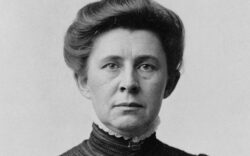He was “the man who fell to Earth” in real life, not in science fiction.
Joe Kittinger was an aerospace pioneer who died recently in Florida at 94. On Aug. 16, 1960, Kittinger stood in an open gondola carried aloft from the New Mexico desert by a giant helium-filled balloon, reaching a record-breaking altitude of over 100,000 feet. The aeronaut was above 99% of Earth’s atmosphere with only his spacesuit to protect him from an airless environment with a frigid temperature of more than 90 degrees below zero. Stars shone unblinkingly in the black sky above Kittinger, and the young Air Force captain could clearly see the majestic curvature of his home planet nearly 20 miles below. “Lord, take care of me now,” he prayed. Then he jumped.
Kittinger fell nearly 16 miles in less than five minutes before his parachute opened. During his daring free-fall he reached an almost supersonic speed of more than 600 miles per hour.
Kittinger’s exploit awed Americans during the Cold War, but it was more than just a stunt. Years before humans first rode rockets into space in 1961, Kittinger risked his life in a series of high-altitude balloon flights testing pressure suits and life support systems like those later used by America’s astronauts. During his 1960 ascent, Kittinger radioed words of caution for future space travelers: “As you look up, the sky looks beautiful but hostile. As you sit here, you realize that man will never conquer space. He will learn to live with it, but he will never conquer it.”
An automatic camera took color photos of Kittinger’s leap, and a stunning image of the spacesuited aviator falling toward distant clouds was seen by millions on the cover of the Aug. 29, 1960 issue of Life magazine. Inside the magazine, a story headlined “Space Race Soars With a Vengeance” trumpeted Kittinger’s accomplishment alongside a report of the frenzied pace of Russian and American satellite launches during that summer. The 1960 photo of a vulnerable Kittinger alone in the void was an eerie foreshadowing of a photo of spacewalking astronaut Ed White outside his orbiting Gemini capsule on Life’s cover five years later.
Years before astronauts like John Glenn and Neil Armstrong became known to millions, Kittinger was showing that combination of skill, courage, cockiness and professionalism that author Tom Wolfe called “The Right Stuff.” On a flight to the edge of space in 1957 during the Air Force’s aptly-named Man High program, Kittinger’s radio transmitter went dead, forcing him to communicate by Morse code. When mission controllers told him to end the flight, Kittinger showed his puckish sense of humor, tapping out a Morse code reply from his lofty perch so high above the world: “Come up and get me.” That phrase would later become the title of Kittinger’s 2011 memoir of his life of aerospace adventure.
What a life it was! As a fighter pilot, Kittinger flew hundreds of missions during the Vietnam War until he was shot down in 1972. He spent 11 months of torture and confinement in the infamous Hanoi Hilton POW prison.
Kittinger retired from the Air Force as a colonel in 1978 but never lost his love for flying. In 1984 he became the first person to complete a solo flight across the Atlantic Ocean by balloon. Kittinger’s 1960 record for his skydive was not broken until 2012, when aeronaut Felix Baumgartner jumped from a balloon floating 24 miles above Earth. Kittinger lent his experience to that endeavor as a reassuring radio voice communicating with Baumgartner during the flight.
Kittinger was loved and lionized in his hometown of Orlando, where he ran a successful aviation business. “My office is still the sky,” he always said.
Kittinger’s step from the edge of space in 1960 led the way to Neil Armstrong’s footprints on the moon in 1969. Kittinger’s flights to the edge of space and back were done for science, but the photos of him falling toward faraway cloudtops were like words from Robert Heinlein’s science fiction: “I pray for one last landing/ On the globe that gave me birth./ Let me rest my eyes on the fleecy skies/ And the cool, green hills of Earth.”
Like what you just read? Support Flagpole by making a donation today. Every dollar you give helps fund our ongoing mission to provide Athens with quality, independent journalism.










